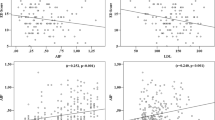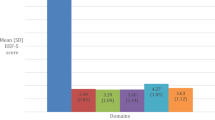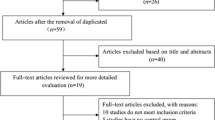Abstract
Although it has been evaluated that even 76% of men with chronic obstructive pulmonary disease suffer from erectile dysfunction, the association has been poorly characterised. The aim of the study was to describe the association between forced expiratory volume in first second and erectile dysfunction in apparently healthy men. All together 331 men aged 45–70 years old were randomly drawn from a cross-sectional population-based study conducted in 2005 in Finland. Decreased forced expiratory volume was defined by performing mini-spirometry and erectile dysfunction by International Index of Erectile Function short form questionnaire. After adjustment for age and depressive symptoms predicted forced expiratory volume (FEV1 < 65%) was associated with 2.66 (95% CI, 1.18–5.99) increased risk of moderate to severe erectile dysfunction (International Index of Erectile Function short form score < 17). Therefore, the authors highlight the importance of erectile and sexual health evaluation and treatment, if necessary, in men with decreased lung function.
This is a preview of subscription content, access via your institution
Access options
Subscribe to this journal
Receive 8 print issues and online access
$259.00 per year
only $32.38 per issue
Buy this article
- Purchase on Springer Link
- Instant access to full article PDF
Prices may be subject to local taxes which are calculated during checkout


Similar content being viewed by others
References
NIH Consensus Conference. Impotence. NIH consensus development panel on impotence. J Am Med Assoc. 1993;270:83–90.
Green JS, Holden ST, Ingram P, Bose P, St George DP, Bowsher WG. An investigation of erectile dysfunction in Gwent, Wales. BJU Int. 2001;88:551–3.
Imai A, Yamamoto H, Hatakeyama S, Iwabuchi I, Yoneyama T, Hashimoto Y, et al. Risk factors for erectile dysfunction in healthy Japanese men. Int J Androl. 2010;33:569–73.
Goldstein I, Lue TF, Padma-Nathan H, Rosen RC, Steers WD, Wicker PA. Oral sildenafil in the treatment of erectile dysfunction. Sildenafil study group. N Engl J Med. 1998;338:1397–404.
Feldman HA, Goldstein I, Hatzichristou DG, Krane RJ, McKinlay JB. Impotence and its medical and psychosocial correlates: results of the Massachusetts Male Aging Study. J Urol. 1994;151:54–61.
Mercer CH, Fenton KA, Johnson AM, Wellings K, Macdowall W, McManus S, et al. Sexual function problems and help seeking behaviour in Britain: national probability sample survey. BMJ. 2003;327:426–7.
Ettala OO, Syvänen KT, Korhonen PE, Kaipia AJ, Vahlberg TJ, Boström PJ, et al. High-intensity physical activity, stable relationship, and high education level associate with decreasing risk of erectile dysfunction in 1000 apparently healthy cardiovascular risk subjects. J Sex Med. 2014;11:2277–84.
Wu C, Zhang H, Gao Y, Tan A, Yang X, Lu Z, et al. The association of smoking and erectile dysfunction: results from the Fangchenggang Area Male Health and Examination Survey (FAMHES). J Androl. 2012;33:59–65.
Chen K, Mi H, Gao Y, Tan A, Lu Z, Wu C, et al. Metabolic syndrome: a potential and independent risk factor for erectile dysfunction in the Chinese male population. Urology. 2012;80:1287–92.
Vlachopoulos CV, Terentes-Printzios DG, Ioakeimidis NK, Aznaouridis KA, Stefanadis CI. Prediction of cardiovascular events and all-cause mortality with erectile dysfunction: a systematic review and meta-analysis of cohort studies. Circ Cardiovasc Qual Outcomes. 2013;6:99–109.
Blanker MH, Bohnen AM, Groeneveld FP, Bernsen RM, Prins A, Thomas S, et al. Correlates for erectile and ejaculatory dysfunction in older Dutch men: a community-based study. J Am Geriatr Soc. 2001;49:436–42.
Fletcher EC, Martin RJ. Sexual dysfunction and erectile impotence in chronic obstructive pulmonary disease. Chest. 1982;81:413–21.
Karadag F, Ozcan H, Karul AB, Ceylan E, Cildag O. Correlates of erectile dysfunction in moderate-to-severe chronic obstructive pulmonary disease patients. Respirology. 2007;12:248–53.
Kahraman H, Sen B, Koksal N, Kilinç M, Resim S. Erectile dysfunction and sex hormone changes in chronic obstructive pulmonary disease patients. Multidiscip Respir Med. 2013;8:66.
Köseoğlu N, Köseoğlu H, Ceylan E, Cimrin HA, Ozalevli S, Esen A. Erectile dysfunction prevalence and sexual function status in patients with chronic obstructive pulmonary disease. J Urol. 2005;174:249–52. discussion 52.
Korhonen P, Aarnio P, Saaresranta T, Jaatinen P, Kantola I. Glucose homeostasis in hypertensive subjects. Hypertension. 2008;51:945–9.
Lindström J, Tuomilehto J. The diabetes risk score: a practical tool to predict type 2 diabetes risk. Diabetes Care. 2003;26:725–31.
Rosen RC, Cappelleri JC, Smith MD, Lipsky J, Pena BM. Development and evaluation of an abridged, 5-item version of the International Index of Erectile Function (IIEF-5) as a diagnostic tool for erectile dysfunction. Int J Impot Res. 1999;11:319–26.
Viljanen AA, Halttunen PK, Kreus KE, Viljanen BC. Spirometric studies in non-smoking, healthy adults. Scand J Clin Lab Invest Suppl. 1982;159:5–20.
Beck AT, Ward CH, Mendelson M, Mock J, Erbaugh J. An inventory for measuring depression. Arch Gen Psychiatry. 1961;4:561–71.
Koponen H, Jokelainen J, Keinänen-Kiukaanniemi S, Vanhala M. Depressive symptoms and 10-year risk for cardiovascular morbidity and mortality. World J Biol Psychiatry. 2010;11:834–9.
Collins EG, Halabi S, Langston M, Schnell T, Tobin MJ, Laghi F. Sexual dysfunction in men with COPD: impact on quality of life and survival. Lung. 2012;190:545–56.
Karadag F, Ozcan H, Karul AB, Yilmaz M, Cildag O. Sex hormone alterations and systemic inflammation in chronic obstructive pulmonary disease. Int J Clin Pract. 2009;63:275–81.
Maurer J, Rebbapragada V, Borson S, Goldstein R, Kunik ME, Yohannes AM, et al. Anxiety and depression in COPD: current understanding, unanswered questions, and research needs. Chest. 2008;134:43S–56S.
Koponen P, Borodulin K, Lundqvist A, Sääksjärvi K, Koskinen S. Terveys, toimintakyky ja hyvinvointi Suomessa: FinTerveys 2017 -tutkimus. National Institution of Health and Welfare, Helsinki, Finland; 2018.
Funding
The work was funded by Central Satakunta Health Federation of Municipalities, Varsinais-Suomi Hospital District, The Finnish Medical Foundation and the Cultural Foundation of Finland.
Author information
Authors and Affiliations
Corresponding author
Ethics declarations
Conflict of interest
The authors declare that they have no conflict of interest.
Ethical statement
The study was assessed and approved by the ethics committee of Satakunta Hospital District. All study participants signed an informed consent.
Additional information
Publisher’s note: Springer Nature remains neutral with regard to jurisdictional claims in published maps and institutional affiliations.
Rights and permissions
About this article
Cite this article
Ettala, O.O., Saaresranta, T., Syvänen, K.T. et al. Decreased forced expiratory volume in first second is associated with erectile dysfunction in apparently healthy men. A preliminary study.. Int J Impot Res 32, 420–425 (2020). https://doi.org/10.1038/s41443-019-0184-1
Received:
Revised:
Accepted:
Published:
Issue Date:
DOI: https://doi.org/10.1038/s41443-019-0184-1



